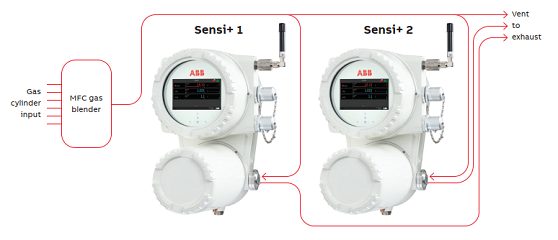
Brought to you by ABB Measurement and Analytics
Natural gas quality monitoring with fast, accurate and reliable measurement of H₂S, H₂O and CO₂ using Off-Axis Integrated Cavity Output Spectroscopy (OA-ICOS).

March 4, 2024 in Features
By Stefan Parmentier, ABB Global Product Manager - Industrial OA-ICOS
 Experimental test setup using an MFC-based gas blender to make natural gas mixtures with high and low amounts of contaminants while two Sensi+ analyzers measured the resulting gas blend in parallel.
Experimental test setup using an MFC-based gas blender to make natural gas mixtures with high and low amounts of contaminants while two Sensi+ analyzers measured the resulting gas blend in parallel. ABB’s Sensi+™ is a compact natural gas contaminants analyzer based on a unique tunable diode laser (TDL) technology known as Off-Axis Integrated Cavity Output Spectroscopy (OA-ICOS). The technology accurately, reliably and simultaneously measures corrosive substances such as hydrogen sulfide, carbon dioxide and water in real time within complex and time-varying natural gas streams.
Fast response time is essential to enable pipeline operations to take quick actions to process upsets. Gas quality measurements are conducted upstream from custody transfer connections. If an upset is detected, the gas must be diverted before being transferred. Faster response in measuring contaminants enables a faster flow rate in the pipeline, maximizing gas network uptime, minimizing product waste, and ensuring safety and productivity.
Many conventional analyzers have long cycle times and can’t update measurements fast enough to detect rapid changes in contaminant gases. TDLs can be scanned quickly to provide measurement updates in seconds. While all TDL-based analyzers can claim to have fast measurement update times, they don’t all provide a quick response.
The measurement update time is how often the analyzer reports a new value that’s based on the laser scan rate and the average number of cycles. On the other hand, the response time also includes the time for the gas to flow through the analyzer and register a change in the instrument response so the end user can take action. One commonly used method to achieve faster response times is to use high sample flow rates. Unfortunately, these high emission rates are harmful to the environment.
OA-ICOS is a cavity enhanced technique in which laser light is bounced back and forth between highly reflective mirrors where it is absorbed by contaminant gases over kilometers of effective path length within a physically small gas cell at vacuum pressure. Thus, extremely sensitive measurements can be made with a low volume sample cell. This small volume means that low sample flow rates can still be used while achieving fast response times. Additionally, Sensi+ measures multiple contaminants, eliminating the waste of redundant emissions from each individual gas analyzer.
Commercial grade plumbing components have “crevices” where trace amounts of some gases, including H2O and H2S, can become trapped. As the gas composition, temperature, or pressure change, gases will be adsorbed or desorbed at different rates leading to inconsistent measurements and slow response to changes. Sensi+ minimizes this memory effect by using custom-designed, machined and treated components in the wetted path.

A, C and E show the instrument response from two Sensi+ analyzers while the gas mixture was repeatably switched between high and low amounts of H2S, H2O, and CO2.
B, D and F show a closer view of the last response highlighting the portion of the response between 10% and 90% of the step change defining the rise time.
With a sample flow rate of less than 0.4 SLPM (0.014 SCFM), Sensi+ can measure H2S, H2O and CO2 simultaneously in real time with rise (fall) times, as defined by IEC 61207, less than 10 seconds for H2S and CO2 and less than 35 seconds for H2O. The measurement update time is less than 2 seconds, which provides sufficient time resolution during transitions.
To demonstrate the response time, two Sensi+ analyzers, configured to measure all three gas contaminants, were installed in parallel to measure a natural gas stream while the contaminant gases were switched between high and low values. A custom, multiple gas blender based on mass flow controllers (MFCs) was used to make the natural gas mixture and switch the amount of contaminant gas. Figure 2 shows the rise and fall of the measurement as the steps were repeated five times. Table 1 summarizes the recorded rise and fall times. Both analyzers responded quickly, consistently and repeatably. With Sensi+, you can maximize your productivity with the confidence that you can take immediate action if necessary due to the fast instrument response.
